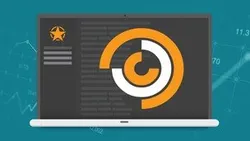
QuantConnect Boot Camp in Python 
Attend QuantConnect's Boot Camp to gain the skills necessary to design and implement algorithmic trading strategies in Python. Learn how to create your own quantitative trading algorithms. ▼
ADVERTISEMENT
Course Feature
![]() Cost:
Cost:
Free
![]() Provider:
Provider:
Udemy
![]() Certificate:
Certificate:
Paid Certification
![]() Language:
Language:
English
![]() Start Date:
Start Date:
On-Demand
Course Overview
❗The content presented here is sourced directly from Udemy platform. For comprehensive course details, including enrollment information, simply click on the 'Go to class' link on our website.
Updated in [April 29th, 2023]
The QuantConnect Boot Camp in Python is a tutorial series designed to teach the fundamentals of quantitative trading. Participants will learn how to work with financial and alternative data, implement trading strategies, use QuantConnect's API, and design robust algorithms. Through code-along tasks, participants will gain the skills to create individual algorithms and build an institutional-grade system using the Algorithm Framework. They will also learn how to manage portfolios, use indicators in technical trading strategies, trade on universes of assets, automate trades based on market behavior, and understand how data moves in and out of algorithms. This course is suitable for participants of all backgrounds and is a great opportunity to learn the skills necessary to implement unique ideas.
[Applications]
Upon completion of this course, participants will be able to apply their knowledge of QuantConnect's API and robust algorithm design to create their own quantitative trading strategies in Python. They will be able to backtest and deploy their algorithms, manage their portfolios, use indicators in technical trading strategies, trade on universes of assets, and automate trades based on market behavior. Additionally, participants will have access to the QuantConnect community, which provides a platform for collaboration and exchange of ideas.
[Career Paths]
1. Quantitative Trader: Quantitative traders use mathematical models and algorithms to analyze financial markets and make trading decisions. They are responsible for developing and executing trading strategies, monitoring market conditions, and managing risk. This job requires a strong understanding of financial markets, quantitative analysis, and programming.
2. Quantitative Analyst: Quantitative analysts use mathematical models and algorithms to analyze financial markets and develop trading strategies. They are responsible for researching and developing new trading strategies, analyzing market data, and developing risk management systems. This job requires a strong understanding of financial markets, quantitative analysis, and programming.
3. Algorithmic Trader: Algorithmic traders use computer algorithms to analyze financial markets and make trading decisions. They are responsible for developing and executing trading strategies, monitoring market conditions, and managing risk. This job requires a strong understanding of financial markets, quantitative analysis, and programming.
4. Quantitative Developer: Quantitative developers use programming languages to develop and implement trading strategies. They are responsible for developing and testing trading algorithms, analyzing market data, and managing risk. This job requires a strong understanding of financial markets, quantitative analysis, and programming.
The development trends for these positions are increasing automation, the use of machine learning and artificial intelligence, and the use of big data to make more informed decisions. As technology advances, these positions will become more important and in-demand.
[Education Paths]
1. Bachelor of Science in Quantitative Finance: This degree program focuses on the application of mathematics, statistics, and computer science to the financial markets. Students learn about financial markets, financial instruments, and risk management. They also learn about quantitative methods such as derivatives pricing, portfolio optimization, and algorithmic trading. This degree is ideal for those interested in a career in quantitative finance, such as a quantitative analyst, portfolio manager, or risk manager.
2. Master of Science in Financial Engineering: This degree program focuses on the application of mathematics, statistics, and computer science to the financial markets. Students learn about financial markets, financial instruments, and risk management. They also learn about quantitative methods such as derivatives pricing, portfolio optimization, and algorithmic trading. This degree is ideal for those interested in a career in quantitative finance, such as a quantitative analyst, portfolio manager, or risk manager.
3. Master of Science in Data Science: This degree program focuses on the application of data science techniques to the financial markets. Students learn about data analysis, machine learning, and artificial intelligence. They also learn about quantitative methods such as derivatives pricing, portfolio optimization, and algorithmic trading. This degree is ideal for those interested in a career in quantitative finance, such as a quantitative analyst, portfolio manager, or risk manager.
4. Master of Science in Financial Technology: This degree program focuses on the application of technology to the financial markets. Students learn about financial markets, financial instruments, and risk management. They also learn about quantitative methods such as derivatives pricing, portfolio optimization, and algorithmic trading. This degree is ideal for those interested in a career in quantitative finance, such as a quantitative analyst, portfolio manager, or risk manager.
Pros & Cons

Free on Youtube

Good match

Practical use of programming skills

Focus on QuantConnect platform

Introduction to Algorithm Framework

Access to data on the QC platform

Open door to quant world

Code programming screen too small

Low resolution

Documentation needs improvement

Design of quantconnect is tangled

Systematic and intuitive training needed
Course Provider

Provider Udemy's Stats at AZClass
Discussion and Reviews
0.0 (Based on 0 reviews)
Explore Similar Online Courses

Foundations of International Psychiatry

How to Draw Step by Step for Kids and Beginners

Python for Informatics: Exploring Information

Social Network Analysis

Introduction to Systematic Review and Meta-Analysis

The Analytics Edge

DCO042 - Python For Informatics

Causal Diagrams: Draw Your Assumptions Before Your Conclusions

Whole genome sequencing of bacterial genomes - tools and applications

Beginner Stock Market Day Trading Course

Mastering Day Trading Stock Market Trading Course


Start your review of QuantConnect Boot Camp in Python